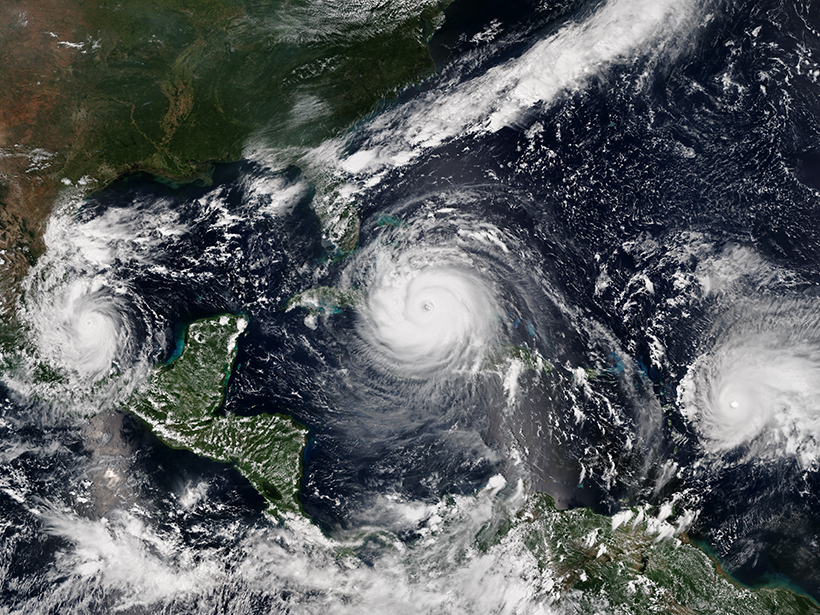Coastal states should brace for three to six major Atlantic hurricanes this season, according to a forecast released by the National Oceanic and Atmospheric Administration (NOAA) today. There is a 60% chance of an above-normal storm season, 30% chance of an average season, and 10% chance of a below-normal season.
The agency predicts 13 to 19 named storms, of which 6 to 10 are hurricanes, including 3 to 6 major hurricanes (category 3 or higher). On average, a typical year has 12 named storms, 6 of which become hurricanes, including 3 that grow into major hurricanes, according to NOAA.
“The 2020 Atlantic hurricane season is expected to be a busy one.”
“The 2020 Atlantic hurricane season is expected to be a busy one,” Gerry Bell, NOAA’s lead seasonal hurricane forecaster at the Climate Prediction Center, said in a news conference today.
NOAA issues a forecast each spring for the Atlantic hurricane season that runs from 1 June to 30 November. Among all the factors considered, tropical Atlantic and Caribbean sea surface temperatures, Atlantic trade winds, and the phase of the El Niño–Southern Oscillation will affect the upcoming season.
Climate change has made storms more intense, according to research released this week in the Proceedings of the National Academy of Sciences of the United States of America. With each passing decade since 1979, we have had about a 6% higher chance of a category 3 hurricane or larger. Category 3 storms have winds faster than 178 kilometers per hour, strong enough to snap trees, remove roof decking, and cause devastating damage, said the National Hurricane Center.
“If 2020 becomes an above-normal season, it will make a record of five consecutive above-normal Atlantic hurricane seasons,” Bell said.
A Recipe for a Hurricane
Two climate conditions contributed to the projection of a more active season this year: the warm phase of the Atlantic Multidecadal Oscillation and the neutral to La Niña phase of the El Niño–Southern Oscillation.
The Atlantic Multidecadal Oscillation is a naturally occurring climate phase that lasts about 20–40 years. The warm phase of the oscillation, which began around 1995, boosts sea surface temperatures, decreases the vertical wind shear, and enhances the African monsoon this year, leading to more favorable storm conditions.
La Niña events typically boost hurricane seasons by weakening the vertical wind shear over the Atlantic.
The season could become highly active, on the upper end of predictions, if a La Niña develops. La Niña is one phase of the El Niño–Southern Oscillation, and La Niña events typically amp up hurricane seasons by weakening the vertical wind shear over the Atlantic. There is a 50% chance of neutral conditions this year (no El Niño or La Niña) and a 40% chance of a La Niña, according to NOAA’s 14 May forecast. The agency will issue an updated forecast around 10 June.
Bell said that climate change was not a major driver in Atlantic hurricane conditions this year.
Other forecasts by universities, private companies, and governments also predict higher-than-average storm activity this year, with the exception of one model based in Reading, United Kingdom. An average of 17 named storms and 8 hurricanes have been forecasted by 13 models, according to CNN. The Reading model, that of the European Centre for Medium-Range Weather Forecasts, has predicted lower storm counts than those observed in the past several years, according to CNN.
Emergency Response Put to the Test
This year may be reminiscent of 2005, the most active hurricane season on satellite record, Michael Mann, an atmospheric scientist and contributor to Pennsylvania State University’s hurricane forecast, told Wired. In 2005, 27 named storms developed, 14 of which became hurricanes. Three storms in 2005 grew to category 5 hurricanes, including Hurricane Katrina, which killed more than a thousand people.
FEMA urges residents to evacuate to friends and family instead of emergency shelters and stay home unless in an evacuation zone.
On 20 May, the Federal Emergency Management Agency (FEMA) issued new guidance for storm preparedness during the pandemic caused by the novel coronavirus (COVID-19). Among them, FEMA urges residents to evacuate to friends and family instead of emergency shelters and stay home unless in an evacuation area.
Florida has already accounted for the novel coronavirus in their hurricane emergency preparedness tasks. One emergency manager spoke about stockpiling masks, and another laid out procedures for safely housing evacuees: temperature checks and isolation for people with COVID-19 symptoms. Typically, municipalities rely on wide-open spaces like gymnasiums for shelter, but the American Red Cross and other organizations are looking into using hotels, dormitories, and other alternatives.
Only time will tell how many hurricanes will make landfall because NOAA’s forecasts can’t predict storm tracks months in advance. In 2010, a particularly active hurricane season in the Atlantic, not 1 of the 12 hurricanes made landfall in the United States. There was a 1-in-70 chance of so few hurricanes coming ashore, according to CNN.
“We always say that it only takes one big hurricane landfall to be a bad season,” said CNN meteorologist Taylor Ward. “So all coastal residents should certainly be paying close attention and have their hurricane plan ready for the upcoming season.”
—Jenessa Duncombe (@jrdscience), Staff Writer
Citation:
Duncombe, J. (2020), NOAA predicts busy hurricane season, Eos, 101, https://doi.org/10.1029/2020EO144552. Published on 21 May 2020.
Text © 2020. AGU. CC BY-NC-ND 3.0
Except where otherwise noted, images are subject to copyright. Any reuse without express permission from the copyright owner is prohibited.

